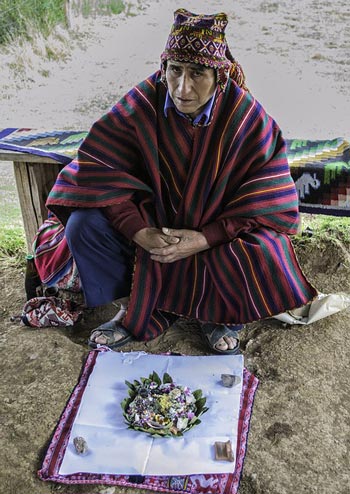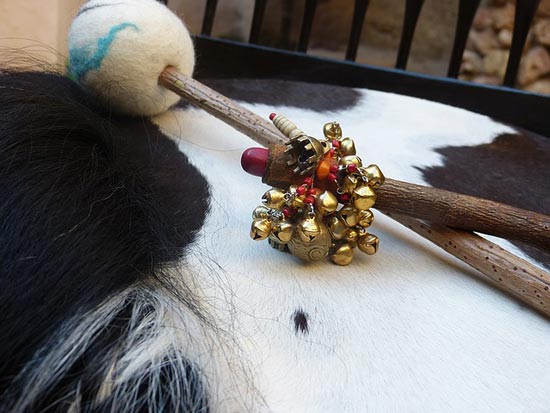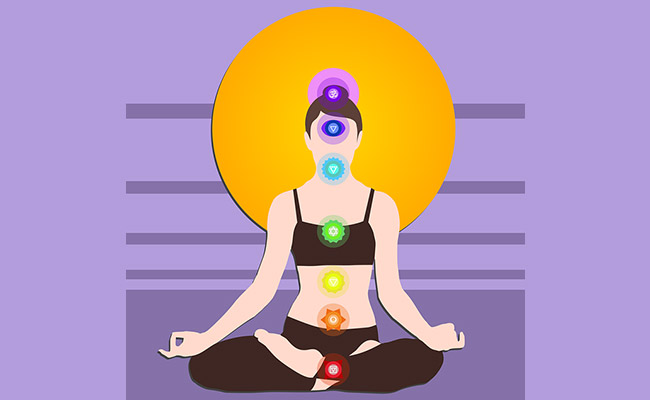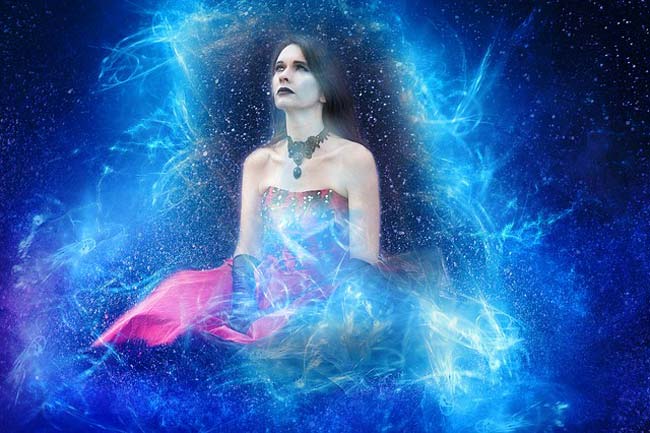Shamanism is arguably the most ancient healing modality. Even in today’s age, some indigenous cultures in different regions around the world still include shamanism in their practices.
As such, it remains of huge interest to the Western world, not least because of its spiritual approach to healing, and the inclusion of hallucinogenic substances to access higher consciousness.
What's so very interesting is that even though there are some differences in the “practices” across different cultures, the general healing techniques like soul retrieval, chakra illumination, etc (which we'll cover.,) have remained the same.
In this post I'm going to explore everything there is to know about shamanic healing, including how you can take of journey of your own, and what to expect along the way.
Grab a hot drink and let's do this!

A Shaman in Peru, not looking too happy at having his picture taken.
What is a Shaman and Shamanism?
A word from the Siberian Tungus tribe, shaman is directly translated as ‘spiritual healer’; however, it can also be interpreted as ‘one who sees in the dark’.
Shamans perform shamanism, a practice revolving around spiritual healing that aims to bring balance by making connections to the spirit realm. It is traced back to the ancient times and may have been introduced around 30,000 years ago.
Shamans are healers who carry out healing sessions by switching into altered states of consciousness to address problems that cause spiritual imbalance and in turn affect mental and physical health.
The power and information required for healing can be found in the spirit realm, which is a hidden, invisible place.
Within a community setting, a shaman is responsible for accessing the spirit realms so that the community can be given access to healing, thus paving the way for changes in the physical world.
Techniques that characterize shamanism include retrieval of souls and power animals, with the differences being marked by retrieving a lost soul for the former and a spiritual guardian or power animal for the latter.
Shamans are crucial to the community, and they can be differentiated from spiritual travelers or sorcerers simply by looking at their abilities to induce changes in the physical realm.
Shamans are considered wise, and respected in the same way a good philosopher might be: In that they offer a unique understanding regarding the balance between the human condition, nature and the spirit world.
With the important role that shamans play in keeping the balance in these aspects, they truly contribute a lot to the communities within which they reside.
What is Shamanic Healing?
Shamanic healing is not physical healing. Instead, it is a healing process conducted by addressing spiritual problems, so that a state of wholeness can be achieved.
With the help of a shaman’s abilities in taking control of an individual’s divine or soul energy, spiritual healing takes place in the spirit.
The goal is to restore balance to a person's life by working through spiritual blockages.
Health issues may stem from a loss of power or energy, and it is the shaman’s responsibility to save their clients from any negativity that surrounds them.
A shaman may take control of someone’s spirit, but it is worth noting that an individual is accountable for his/her own healing. One must be willing to be healed in order to gain the benefits of spiritual healing.
Moreover, shamanic healing alone should not be carried out as a replacement for medical or psychological treatment, but rather should be used as a complementary form of treatment.
Shamanic healing involves two practices: a shamanic healing session, and a shamanic plant medicine healing ceremony.
However, there are modern-day shamans who no longer stick to the traditional method of using plant medicines. They use other techniques instead of utilizing substances or plant medicines that alter the state of the mind.
Some techniques can also be self-taught, so a shaman may no longer need to fully accompany a person on his/her spiritual journey.

How Does a Person Become a Shaman?
There is no single way to becoming a shaman.
Shamans are generally chosen either by initiation or by calling, and some are also meant to be shamans by the time they are born.
Formal training alone may not turn an individual into a shaman, as it takes a lot of life experience to be awakened to this path.
A shaman can be designated even before he is born, and this is made possible by incarnation (a person who embodies in the flesh a deity, spirit, or quality).
The abilities of a shaman can also be learned, especially if an elder shaman passes down the knowledge and skills to a young, aspiring shaman.
Shamanic initiation can also be conducted to test the courage of a person willing to be a shaman. In this manner, difficult challenges may be bestowed on them to help in developing their strength in enduring trials.
At the same time, healing also takes place and plays a huge role in their growth as a true shaman.
These initiations may come in the form of dreams or out-of-the-body experiences, wherein they encounter being broken into pieces, only to be formed again as a whole, thus completing the process of being a true shaman.
Some people become shamans by going through difficult circumstances such as grave illnesses or near-death experiences. This happens when they encounter spirits or ghosts of their ancestors, thereby making them different from other individuals who have never been through such unusual experiences.
What are a Shaman’s Special Abilities?
It is not easy to become a shaman, and only a few are recognized as real if they have certain abilities.
First, a shaman knows how to fully control switching between altered states of consciousness.
He/she can act as a mediator between the spiritual and physical realms. Wisdom and teachings from the spiritual realm are applied to the physical realm so that the community can be healed accordingly.
Moreover, a shaman takes charge of creating and maintaining the balance in the following aspects: humans, nature, spirit.
Not everyone can be a shaman, and it certainly is a long, challenging path to take before one can be called a true spiritual healer.
What is a Shamanic Journey?
The spirit realm, which is named differently across other cultures, is where the shamanic journey takes place. It is a place that is not seen by the naked eye, and it is not bound by time or physical reality.
Altered states of consciousness are the paths taken by shamans to embark on a shamanic journey. Ceremonies are performed to take the prospective shamans in the spirit realm.
Shamans come across spirits in this realm, so they can be guided towards the wisdom they need to successfully perform healing.
How Do You Embark on a Shamanic Journey?
A shaman can reach the spirit realm through a half-conscious state, which is more commonly known as a “trance”.
A ceremony is conducted with the use of percussions, chants and songs to induce the brain into a Theta brainwave state. In this state, the shaman is half-awake and half-asleep, and a spiritual connection is made.
=> After this, read about Theta waves & how to achieve this state
Some plant medicines also help in the spiritual journey. These plants have properties that will help shamans experience the power they need. Some plant medicines used in shamanic healing ceremonies include certain species of mushrooms and cacti.
The most commonly used plant in these ceremonies is Ayahuasca.
Shamans usually refer to it as Mother Ayahuasca because they recognize it as a deity, not to mention it is revered due to its power to induce a shaman into a trance.
Ayahuasca is an entheogenic brew made out of Banisteriopsis caapi vine and other ingredients.The brew is used as a traditional spiritual medicine in ceremonies among the indigenous peoples of the Amazon basin and is known by a number of different names (see below).
B. caapi contains several alkaloids that act as monoamine oxidase inhibitors (MAOIs). Another common ingredient in ayahausca is the shrub Psychotria viridis which contains the primary psychoactive compound, dimethyltryptamine (DMT). MAOIs are required for DMT to be orally active. (Source: Wikipedia)

An Indian shaman takes time out to read the paper.
What are the Common Shamanic Techniques?
Practices may vary from one culture to another, but the distinguishing characteristics of each may still remain the same. The following are some of the commonly used techniques in shamanism:
Soul Retrieval
Out-of-the-body experiences usually occur in dreams. A frightening stimulus usually triggers a response that causes the soul to be fragmented into pieces. The soul fragments are expected to reassemble and make “one” whole again, but such experiences can cause some pieces of the soul to be lost.
Shamans then help their clients heal by helping them find those lost soul pieces. Once the missing fragments return, then the client is considered healed.
Power Animal Retrieval
The energy of a power animal may be used to help clients overcome the challenges they face. There are a many power animals to choose from, with each animal beholding an energy that can address a client’s specific needs.
For instance, the Eagle’s energy may be used to have a better perspective of things, while the Bear’s energy is most appropriate in situations where you need to firmly stand on your ground.
It is worth noting that no power animal is stronger than any other, as each is characterized by a specific quality regarded as powerful on its own.
Cutting of Ties
Some relationships can be toxic events in our lives, and some people are better off severing connections from such harmful or dangerous people.
In recognizing a toxic relationship, a common cure would be to move to a new neighborhood, switch jobs, or break up. In doing so, one can feel less suffocated, which can help them unleash their full potential.
Chakra Illumination
There are 7 commonly known chakras in the body. These are energy channels, along which vital energy, or “prana,” moves.
Suppressed or unaddressed past or present emotions can block (crystallize) chakras and disrupt the flow of positive energy.
Once this happens, blockages will build up in the chakras. Chakra illumination unblocks the energy ecosystem, giving the person renewed emotional strength.
Shamanic Extraction
Similar chakra illumination, shamanic extraction may involve the use of stones, crystals or essence to eliminate the blockages of emotional energy. The improved energy flow in the client’s body translates to a healthier spiritual balance.
Past Life Healing
Issues in life that may deal with karma, suffering or fear are key causes of negativity. These issues manifest in the energy field, so it is essential to eliminate them through sessions of past life healing. These sessions depend on the situation being dealt with and vary according to the needs of the client.
Aura Cleaning/ Extraction
An aura is a field of energy specific to each of us, hence it needs to be extracted for healing. Once deeper healing is encouraged, negative patterns such as abuse and addiction can be cleansed from the spiritual being. To make sure that patterns will no longer recur, additional sessions using psychotherapy are sometimes required.
The Three Worlds of the Shamanic Journey
Also known as the Axus Mundi, the World Tree is often used to depict the three worlds in shamanic cosmology.
All parts of the tree are essential, with the roots, trunks and branches representing the lower, middle and upper worlds respectively. Shamans travel these three worlds to find wisdom and information they need to help and heal the community.
Lower World
This is the home to natural spirits. Nature in its invisible form is found here, and the lower world is where spirit animals and mythical creatures from different landscapes can be communicated with.
It also represents the subconscious mind, because being in the lower world can feel like a lucid dream.
Middle World
The middle world shows the spiritual realm of the physical reality. It is the first phase a shaman (who just left his physical body) will step into. It is tricky to travel this world as lost souls, commonly known as ghosts, are often found here.
Shamans can undergo ‘psychopomp work’, which is a part of the shamanic training that focuses on helping lost souls cross over completely. The conscious mind or the ego is the state represented by the middle world.
Upper World
This world, also known as the ‘heavens’, paints a picture of abstract and imaginative things such as fractals and prisms, among other things. This is where the spirit guides can come in different forms, may they be similar to gods or animals or a mixture of both.
Celestial and planetary beings can be found in this world, thereby making it the world where one can imagine anything and everything. The upper world embodies the super-conscious state of mind that transcends any known boundaries of time and space.
Does Shamanic Healing Involve Drugs or Psychoactive Substances?

Image Credit: (Costa Rica News)
A shamanic journey may sometimes involve the use of drugs. As mentioned earlier, Ayahuasca is the most popular form of drug used in healing sessions. It is regarded as a powerful plant medicine as its usage shows good results in terms of overall optimism against a lower scale of negativity.
In fact, a study has been conducted among people who traveled to South America to use Ayahuasca.
These people were motivated to try Ayahuasca out of curiosity, interest, desire to treat mental health issues and problems, and spiritual development.
The study revealed that on the aspects of intuition, optimism, ambition, charm, and helpfulness, people using Ayahuasca showed results that are significantly above the norm.
They also manifested significantly lower results on the scales of distrust and quietness.
Due to the popularity of Ayahuasca in shamanic healing, some people have misconceptions that it always involves the use of drugs in rituals. However, this is not always the case, and healing is not about getting people high.
Drugs are not required when carrying out healing sessions. Moreover, some countries consider psychoactive drugs illegal, so a shaman might need to use other mediums such as dance, music or meditation to induce a trance state.
Having said that, it is worth noting that psychoactive substances can be helpful for some clients.
These substances are often referred to as ‘drugs’, which connote negativity; hence, the prejudice against their use.
People often focus on drugs that are regarded as addictive and toxic and close their minds towards the fact that some type of drugs are safe and helps in the healing process when consumed in the right doses.
Moreover, psychoactive substances are sometimes used as a means of escape from the harsh reality of life. But outside of this they can be used as tools for self-discovery and positive change.
The use of drugs boils down to your purpose. Are you using it for addiction or for self-betterment?
Shamanism is not about getting people high; rather, it is designed to take people on meaningful journeys that enable them to open their minds to positive changes in themselves and their world.
Healing comes in many forms, but it is good to remember that it is all about improving our awareness of how we think, feel and act.
Let us consider the possibilities in using such substances, such as uncovering the works of our unconscious mind and helping us to change our beliefs, habits and assumptions.
What Happens at a Shamanic Healing Session?
Practices can differ from one country or region to another but some elements can still be recognized across different cultures.
A ‘sacred place’ is the best setting for a healing session, be that indoors or outdoors.
The place should be quiet to fully maximize the benefits of healing.
Items such as burning candles, incense, crystals and stones are usually used along with soothing music. The perfect place will be anywhere that is relaxing and where the client can lie down comfortably.
The shaman initiates an open discussion with the client to further look into the client’s story. He ensures that the space created is safe, with no judgment felt. Doing so ensures that the client is comfortable and willing to share information.
After the conversation is set, the energy work / ceremony begins with the client lying on their back. The shaman begins by working his way through each chakra and assessing each energy center. This is done so certain energies may be eliminated and/or replaced.
After the energy work, the shaman sets expectations as to what the client may go through during the session.
Many people report feeling tingling sensations followed by altered states. An emotional release usually happens before feeling the energy of the spiritual communion.
Once the trance is induced through the use of music and percussions, the shamanic journey starts.

A traditional shaman drum from Northern South America with percussive bells tied to the drumstick.
The shaman connects with the spirit guides and travels across the three worlds to seek wisdom for the client’s healing. The shaman may channel the energy from the spirit and allow it to pass through the client’s body.
This process will usually take about an hour.
The return from the shaman’s journey is followed by another discussion.
Experiences, wisdom, and advice from the session will be discussed to help the client make changes in their life.
Energies are expected to change after a healing session, so you the client may feel shifts in perception with physical effects
Energy shifts are normal due to toxins having been released from the body. Any instances of discomfort are expected to pass to pave the way for new positive energy. Guidance may still be needed, so it is the shaman’s task to check in on the client.
How Do Shamans Perceive Illness?
Shamans have a deep understanding of the difference between healing the body and healing the spirit. The healing of the spirit is viewed as complementary, so a shaman may not be the best person to see if you have a physical injury – unless it is reoccurring for seemingly no apparent reason.
People suffer from different forms of physical injury such as cuts and bruises and grave diseases that can be terminal.
These physical manifestations are considered effects, for which medication alone can only alleviate symptoms. In shamanic healing, the real enemies are not bacteria and viruses but the internal states of an individual.
In shamanic healing, there are three main causes of illness.
1. Disharmony: This is the first cause of illnesses, which occurs when valued relationships are broken or lost, or when a sense of belongingness disappears. Disharmony makes one susceptible to physical illnesses because our personal power or life energy deteriorates due to the loss.
2. Fear: Fear makes us vulnerable. The immune system becomes weak because of constant fear, and the combination of disharmony and fear can be truly detrimental to one’s health.
3. Soul loss: Losing the soul is viewed in shamanic healing as the most dangerous cause of disease. Soul loss often leads to premature death, because the inner essence is seriously wounded.
The inner essence defines a person because it represents who we are and what we are. Losing the soul is usually connected to trauma because the terrifying experience shatters a part of us (eternally).
Other scenarios that can cause us to lose our soul may involve accidents, the death of a loved one, divorce, miscarriage and major fallouts in relationships with other people. Such events are not good for both the heart and soul, thereby leading to a terminal fragmentation of the soul.
To address these factors that contribute to spiritual imbalance, there are different stages in healing.
- First, an increase in power takes place once the patient gains the energy from the shaman.
- Next, the problem is diagnosed to identify the root cause of the illness and its effects.
- The third phase is the healing process itself.
- Lastly, we have the most critical phase, which is retrieving the lost soul.
Is There Scientific Evidence That Shamanic Healing Works?
Scientific evidence is limited, which is unsurprising.
Large scale studies require funding, and government funding certainly wouldn't be used to fund the potential benefits of shamanism.
Moreover, the results of any study would be difficult to quantify; because it would rely heavily on the way patients feel, or think they feel.
There are two studies of interest that I found, as follows:
Study 1: Temporomandibular Joint Disorders Study
Temporomandibular disorder, or TMD, can cause pain in your jaw joint and in the muscles that control jaw movement. The exact cause of a person's TMJ disorder is often difficult to determine but the pain is likely to be a combination of factors such as genetics, arthritis or jaw injury.
In one study, eligible volunteers were women aged between 25 to 55 years, naive to shamanic healing, with a confirmed diagnosis of TMD and a pain level of three or higher on the Research Diagnostic Criteria Axis II questionnaire.
The objective was to evaluate participants' perceptions of illness, healing process, and experience of effects from shamanic treatment as reported from in-depth interviews.
Although participants described physical changes, three times as much text was devoted to changes in self-awareness, capacity for coping, improvement in relationships, and taking better care of themselves. Their experience describes a process of transformation.
Study 2: Posttraumatic Stress Disorder (PTSD)
Posttraumatic stress disorder (PTSD) is a serious health concern. Current evidence-based treatments for PTSD are efficacious; however, they are not appropriate or tolerated by everyone who needs them. Shamanic healing is one such therapy that may potentially be beneficial.
A semi-structured shamanic healing study was created with the following components: rapport building, power animal retrieval, extraction, compassionate spirit release, curse unraveling, soul retrieval, forgiveness/cord-cutting, aspect maturing/soul rematrixing, and divination.
Six veterans enrolled in the study (mean age = 49.3 ± 13.1). Qualitative descriptions of the participants, their histories, and effects from the intervention are reported.
Preliminary data was collected on PTSD-related outcomes. The protocol was found feasible and acceptable and recommendations for its future use are suggested. Future research is warranted and needed to evaluate the efficacy of shamanic healing as a potential therapy for veterans with PTSD.
In Conclusion
Shamanism heals by channeling transcendental energies from spiritual realms into the physical world.
let's face it: it requires a leap of faith, and is by no means scientific.
Yet surprisingly there remains a lot of interest from various corners of the scientific community and scholars alike. There is a lot to this and whilst anecdotal, there are thousands upon thousands of people who report amazing, transcendental experiences.
Shamanism has stood the test of time. Still now, in the 21st-century, people all over the world turn to shamans to cure their ills.
We humans have a yearning to know what's on the other side; whether there are other forces at play in our lives, pulling the strings and controlling our destinies. The thought that a mystical person with a gift can heal us from the inside out by acting as a medium between these forces is a rabbit hole we are compelled to explore.
As always, my mind remains open to the possibilities, yet I'm somewhat skeptical because I like at least a moderate dose of science with my alternative remedies.
My opinion is not that shamanism doesn't work, but that much of the healing might simply be achieved through entering the Theta state and accessing the subconscious mind.
The subconscious mind, as I discuss extensively in this post, is where all our beliefs are stored; the beliefs that drive our everyday emotions and actions and ultimately determine the outcome of our lives.
I cannot be sure. I have no evidence that these spiritual realms, as they are purported to be constructed, actually exist. They may, though…
Have you had a shaman healing experience? Let me know all about it in the comments section.



Leave a Reply